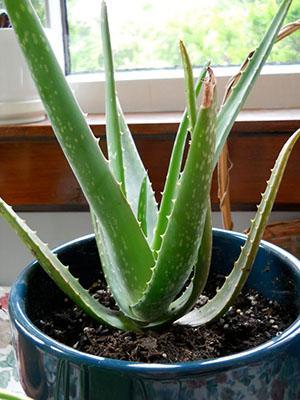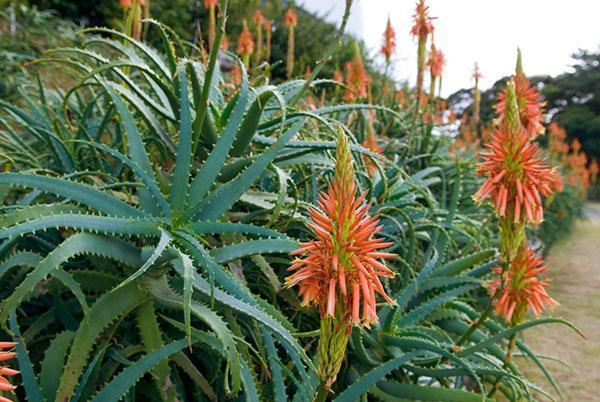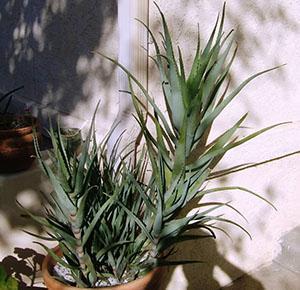Growing, caring for and propagating aloe at home
 A succulent shrub native to the Arabian Peninsula and from the southeastern regions of Africa is well known to Russian flower growers. This is facilitated by the wide recognition of the medicinal properties of the plant and the fact that caring for aloe at home is extremely simple and easy.
A succulent shrub native to the Arabian Peninsula and from the southeastern regions of Africa is well known to Russian flower growers. This is facilitated by the wide recognition of the medicinal properties of the plant and the fact that caring for aloe at home is extremely simple and easy.
Unpretentious large plants in nature tolerate temperatures from 5 to 40 ° C and grow, depending on the species, up to three meters in height. Aloe is easily recognizable by its long, jagged, succulent leaves. Aging, such foliage dries up and falls off, exposing an erect stem. At home, adult plants bloom, and racemose inflorescences can reach 80 cm in length. And the flowers exude a delicate, lily aroma around. Growing aloe at home, you are unlikely to be able to admire its inflorescences. The phenomenon is so rare that that is why the plants got their popular name - the agave.
Read also the article: fuchsia cultivation and care at home, reproduction and pruning!

We grow aloe at home
 The culture can be called unique in terms of endurance and unpretentiousness. Where other plants dry out, freeze or suffer from the heat, aloe firmly endures all adversity.
The culture can be called unique in terms of endurance and unpretentiousness. Where other plants dry out, freeze or suffer from the heat, aloe firmly endures all adversity.
This is a record holder for vitality and stay in dry soil. But one has only to renew watering and move the pot to a comfortable environment, the almost completely dried leaves are filled with juice, and the flower continues to grow.
Although a moderately cool temperature is considered optimal for the growth of a succulent, you can grow aloe at home without worrying about creating a special temperature regime. In the warm season, when the time of frost has passed, it is useful to take a pot of aloe into the fresh air. Both here and indoors, the plant is looking for a well-lit place where indirect rays of the sun will fall on juicy leaves. If there is not enough light, the plant signals the twisting of leaf plates, they lose their richness of color, turn gray.
 With a prolonged stay under the scorching sun, especially in drought conditions, the foliage loses its juiciness, becomes concave, purple or brownish tones appear in its color. In the spring, the flower is gradually taught to stay in the sun, taking it out to the loggia or balcony and gradually increasing the time spent outside the room. Such home care for aloe will help the flower avoid sunburn.
With a prolonged stay under the scorching sun, especially in drought conditions, the foliage loses its juiciness, becomes concave, purple or brownish tones appear in its color. In the spring, the flower is gradually taught to stay in the sun, taking it out to the loggia or balcony and gradually increasing the time spent outside the room. Such home care for aloe will help the flower avoid sunburn.
With the onset of autumn, the aloe is returned to the room, and here it is important to ensure that the length of daylight hours does not decrease and is 12-14 hours.
In the middle lane to ensure this, you will have to use special lighting for plants. In winter, the best place for aloe is a cool, bright room, where the temperature does not exceed 10-14 ° C.
 Undemanding aloe refers to watering and humidity. If other indoor plants suffer in the too dry air of city apartments, then aloe grown at home does not experience any discomfort. He does not need additional spraying, but sometimes he still needs to wash the crowns with warm water. This treatment will improve the flower's appearance and allow it to breathe easier.
Undemanding aloe refers to watering and humidity. If other indoor plants suffer in the too dry air of city apartments, then aloe grown at home does not experience any discomfort. He does not need additional spraying, but sometimes he still needs to wash the crowns with warm water. This treatment will improve the flower's appearance and allow it to breathe easier.
Watering in spring and summer is carried out regularly, as the top layer of the soil dries out. It is better to moisten the soil with purified water, which is 5–8 ° C warmer than the surrounding air. This procedure is combined with weekly feeding, for which ready-made complex formulations for succulents are taken. If the plant has recently been transplanted, it is not worth fertilizing it. Also, do not feed aloe, transplanted for the summer in open ground.
When caring for aloe in the garden, it is important to know that in the rain the bush must be protected from moisture. Accumulating in the center of the outlet, water during a cold snap often causes decay and death of a healthy shoot.
 In winter, caring for aloe at home changes, firstly, the temperature of the content decreases, and secondly, ordinary watering is reduced. This is extremely important if the plant is kept cool. When the pot remains at normal room temperature for the winter, you need to moisten the soil a little more often, while focusing on the state of the foliage and the 2-centimeter layer of the substrate.
In winter, caring for aloe at home changes, firstly, the temperature of the content decreases, and secondly, ordinary watering is reduced. This is extremely important if the plant is kept cool. When the pot remains at normal room temperature for the winter, you need to moisten the soil a little more often, while focusing on the state of the foliage and the 2-centimeter layer of the substrate.
How to transplant aloe at home?
As with most indoor crops, a spring transplant is preferred for aloe. This time is used to divide an adult overgrown bush into several parts.
The younger the flower, the faster it develops. Therefore, plants up to three years of age can be transplanted aloe annually, and then the transshipment frequency is reduced to once every 2–3 years. The day before the transplant, aloe is watered abundantly. This will help to remove and transfer the powerful root system of the plant to a new pot without loss.
The substrate for the succulent is prepared from a mixture of turf, sand and humus. Pieces of charcoal and crushed red brick are added to the soil. Peat, which increases the acidity of the soil, should not be mixed. It negatively affects the growth of the root system and the overall well-being of the aloe. But drainage of this culture is vital. It will help protect the roots from staying in constantly moist soil that threatens the development of rot.
 After the aloe has got into the new substrate, the soil is moistened, and the surface is sprinkled with dry soil. This will help the plant retain moisture and acclimate faster. The first watering after transplanting is carried out only after 5-7 days, and the plant should not be fed for at least another month.
After the aloe has got into the new substrate, the soil is moistened, and the surface is sprinkled with dry soil. This will help the plant retain moisture and acclimate faster. The first watering after transplanting is carried out only after 5-7 days, and the plant should not be fed for at least another month.
 Water the plant abundantly before planting the aloe to make it easier to remove from the pot. The root system is carefully freed, and then divided with a sharp knife so that each shoot has its own roots, sufficient for quick acclimatization.
Water the plant abundantly before planting the aloe to make it easier to remove from the pot. The root system is carefully freed, and then divided with a sharp knife so that each shoot has its own roots, sufficient for quick acclimatization.
A video on how to transplant aloe at home will help you understand the intricacies of the process and will not allow you to make any mistakes when it comes to practice.
How to propagate aloe at home?
The vitality and endurance of aloe is fully reflected in the variety of ways in which it can be propagated. At home, most often offspring from an adult plant are obtained using:
- cuttings, that is, the separation and rooting of lateral shoots;
- the top of a bush or one of their adult shoots;
- sheet;
- daughter rosettes formed at the base of an adult bush;
- seeds.
One of the simplest and most guaranteed successful ways to propagate aloe is by rooting cuttings. Lateral shoots that appear in the axils of mature leaves can be cut all year round. They root easily and acclimate after transplanting.
Such "stepchildren" are cut off at the very base, the cut is processed with coal powder. And then they are not planted in a substrate or put in water, but for 2-4 days they are dried at room temperature in a dark place. Only after such preparation are the cuttings ready for rooting. The same manipulations are carried out before planting aloe without a root, for example, after its decay or unsuccessful division of the bush.
 Cuttings root easily both in wet sand or vermiculite and in plain water.When rooting in the substrate, future plants can be dropped in several pieces at a distance of about 5 cm from each other. The stem is not buried more than 1 cm.If the cuttings are in a humid warm environment, powerful root rudiments appear on the seedlings after a week, and the aloe can be transplanted into separate pots.
Cuttings root easily both in wet sand or vermiculite and in plain water.When rooting in the substrate, future plants can be dropped in several pieces at a distance of about 5 cm from each other. The stem is not buried more than 1 cm.If the cuttings are in a humid warm environment, powerful root rudiments appear on the seedlings after a week, and the aloe can be transplanted into separate pots.
 At home, aloe reproduces without visible problems by daughter rosettes that appear at the very base of an adult flower. How to plant an aloe shoot? Young rosettes have their own root system, so they are free to separate from an adult bush during spring transplantation or in summer.
At home, aloe reproduces without visible problems by daughter rosettes that appear at the very base of an adult flower. How to plant an aloe shoot? Young rosettes have their own root system, so they are free to separate from an adult bush during spring transplantation or in summer.
For several years of growth at home, aloe can reach almost a meter in height. At the same time, its stem is significantly bare, and the leaves remain only at the top.
You shouldn't part with such aloe. It can be rejuvenated by cutting off the top and placing it in a separate pot. To do this, cut off the top of the stem with 6-7 mature leaves.
But how do you transplant aloe without a root? To root such planting material, the top is dried and placed in water. After a few days, roots will appear on the plant, and in the future, the seedling can be easily transplanted into a separate pot.
 Small plants also form at the base of a leaf plucked from the lower tiers of the stem. Before propagating an aloe leaf at home, it, like the cutting, is dried, and then, after being treated with charcoal, the planting material is immersed in water or in sandy soil. In this case, it is extremely important to maintain the moisture content of the substrate, otherwise the sheet will dry out quickly.
Small plants also form at the base of a leaf plucked from the lower tiers of the stem. Before propagating an aloe leaf at home, it, like the cutting, is dried, and then, after being treated with charcoal, the planting material is immersed in water or in sandy soil. In this case, it is extremely important to maintain the moisture content of the substrate, otherwise the sheet will dry out quickly.
 Aloe seed propagation is the longest and most laborious way. Sowing is carried out at the end of winter in a light, loose substrate based on sand and garden soil. At room temperature and high humidity, the seeds hatch quite amicably and grow until a pair of true leaves appear on them. At this time, the aloe dives, transplanting the sprouts into small individual pots. A year later, home care for aloe is carried out as usual.
Aloe seed propagation is the longest and most laborious way. Sowing is carried out at the end of winter in a light, loose substrate based on sand and garden soil. At room temperature and high humidity, the seeds hatch quite amicably and grow until a pair of true leaves appear on them. At this time, the aloe dives, transplanting the sprouts into small individual pots. A year later, home care for aloe is carried out as usual.
Tell me, if I broke off a leaf of aloe immediately at the base (10-15 cm) and immediately put it in a glass of water, should it take root? there it just started to turn black in the place of the cut (change color to brown) or is it better to plant it in the soil?
Good afternoon. Please tell me, is it possible to cut the roots of aloe vera in half so as not to transplant it into a large pot?
Why deprive a flower of nutrition? If you do not want large dishes, then it is better to just plant a bush if there are children. By cutting off half of the roots, you can provoke aloe disease and even death.
Good afternoon. Please tell me how to train aloe vera to the balcony on the south side? I had aloe on the balcony in the shade on the south side and began to dry out. What to do please tell me
Oddly, aloes usually thrive in the fresh air, and on the south side as well. Maybe you rarely water it? Try replanting the bush by checking the roots - maybe the problem lies in them.
Tell me how to be. Aloe spinous like. Not watered for three months. There were many dry leaves. I pulled it out, peeled and washed the roots. I removed the dry leaves. I do not understand what is with his roots and whether it is worth cutting out of it? And how to root it?
I would give all the plants a drink and a little stress relief. At least for a day in water with activated carbon. Further revision and assessment of the condition of the roots of each separately. Plant with live roots in a nutritious soil. On the rest, carefully dip the tips in a root or other stimulant and plant them in the ground for rooting.Unforgettable to spill water with iodine at the rate of 2 drops per liter of water.
How to understand that the roots are alive? And what about the little ones whose roots are very short?
Living roots are juicy on their own. Therefore, I advised you to first put them in water for a day. After a long dry period, the living roots will get their natural appearance after drinking water. Dry dead roots will remain dry and shriveled. The plants in the foreground in the photo have practically no roots. They need to be rooted.